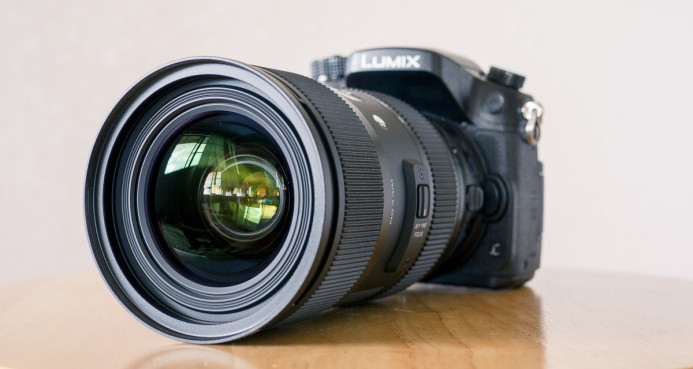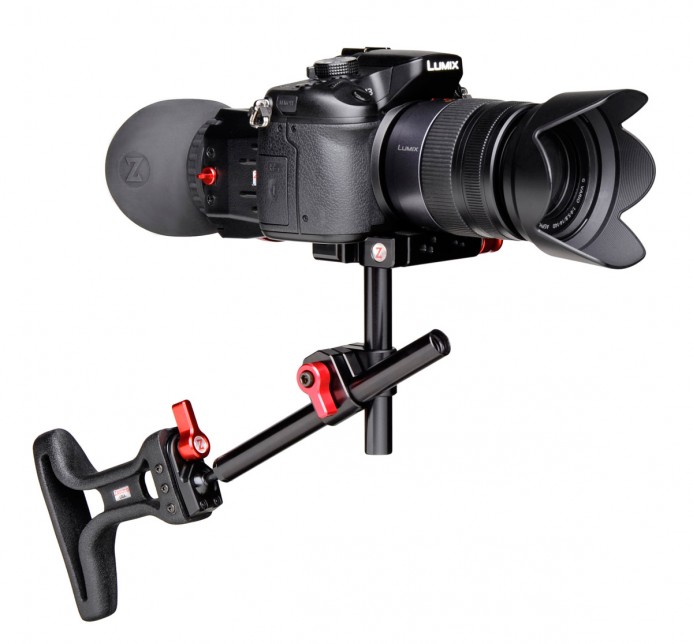Are You a Slave to Stabilized Lenses?
“That’s an awesome lens…too bad it doesn’t have image stabilization.”
Does this sound familiar? If you find yourself writing off lenses simply because they don’t have built-in stabilization, you might be a slave to stabilized lenses.
While stabilized lenses can be useful in certain situations, being dependent on them not only limits your lens options, but can also bring your growth as a filmmaker to a screeching halt.
If that’s not bad enough, using stabilized lenses in the wrong situations can actually ruin your footage.
Let’s take a closer look at why being dependent on stabilized lenses is a problem, and how you can break free and become a better filmmaker in the process.
Lens Stabilization is Not Designed for Motion
Lens stabilization is great for what it was designed for– still photography. A good stabilized lens helps you to shoot sharp stills at much slower shutter speeds than would otherwise be possible.
While not their primary purpose, stabilized lenses can have a noticeable effect when shooting handheld video. However, because they are optimized for stills, the effect may not always be what you expect.
Trying out the Lumix 35-100mm 2.8. Seems great for stills but the OIS doesn't seem optimised for video :( #jitter pic.twitter.com/Ul9lQFZ5cB
— Louis du Mont (@louisdumont) June 24, 2015
As video production is not their primary focus, some stabilized lenses even add instability to your footage, such as Panasonic’s 35-100mm zoom lens.
When you’re not shooting handheld, you need to be even more wary of lens stabilization, as it can work against the other tools such as tripods. Stabilized lenses can cause the image to lag or stutter as it tries to compensate for the panning or tilting of the tripod head.
Bottom line: Lens stabilization is optimized for still photography and can cause issues when used for video.
You’re Missing Out
The other big issue is that your lens options are severely limited when you’re dependent on stabilized lenses. For example, if you shoot with the GH4, only Panasonic makes native stabilized lenses. Even then, many of Panasonic’s best lenses– like the 25mm f/1.4 prime– are not stabilized.
Some active lens adapters like Metabones’ Canon EF Speed Booster allow you to use non-native lenses with image stabilization on cameras like the Panasonic GH4 or the Sony a7S. While you get a wider range of lenses to select from, you are still missing out on some of the best lenses available– such as Sigma’s 18-35mm f/1.8 zoom– that do not feature built-in image stabilization at all.
Of course, when you limit yourself to stabilized lenses, you also miss out on using awesome manual glass such as vintage lenses, anamorphic lenses, and cinema lenses.
Bottom line: You’re missing out on a world of great lenses by depending image stabilization.
Stabilized Lenses Hold You Back
Stabilized lenses can seem like magic, but the real trick is that they might actually be stunting your growth as a filmmaker.
Filmmaking requires both creativity and technical skill, and experience is the key to growing in both of these areas.
Dealing with challenging situations helps you find new and creative ways to tell your story. When you cannot just flip a switch on your lens, you learn how to use other tools and techniques to keep the shot stable.
When you’re not dependent on stabilized lenses, you can become intimately familiar with a wide range of lenses, allowing you to experiment with how each lens affects your footage. This experience is invaluable as it will help you quickly select the right lens for a shot based on its style and tone.
The best thing is that you can take the experience you gained with you from your current project to use on future projects. The creative solutions you discover and the techniques you acquire can be built upon to help you become a better filmmaker with each project.
Bottom line: Experience is the key to becoming a better filmmaker. Don’t let a dependence on stabilized lenses hinder your growth.
Break Free: Use a Rig
One of the key reasons for using stabilized lenses when shooting handheld video is to reduce micro-jitters. Handheld footage should have movement— that’s what gives it character– but micro-jitters are distracting and take the viewer out of the story.
Micro-jitters are especially apparent at longer focal lengths. Here’s an example of micro-jitters in handheld footage shot with a 50mm lens:
Lens stabilization can help with micro-jitters in handheld footage, but there is a limit to the effect it can have. Once the camera’s motion exceeds the stabilizer’s abilities, the stability of your footage cannot be improved any further.
By contrast, a camera rig also reduces micro-jitters in handheld footage, but a rig’s effectiveness actually improves over time.
Simply mounting your camera on a rig can noticeably improve your footage, but as you become more experienced with shooting on a rig, your results will get better and better, resulting in smoother footage.
You also have more control with a rig because you’re not limited by fixed level of stabilization from a lens or the types of movements you can make (as stabilized lenses can become confused by certain camera movements). Using a rig allows you customize the amount of stability in a shot according to the style and tone you want to communicate.
The best thing though is that a rig stabilizes any lens, not just modern lenses with built-in stabilization. The techniques you learn using a rig can be applied to future projects with a completely different set of lenses.
Bottom line: A rig is incredibly versatile, giving you more control in your shooting style and freeing you to choose the best lenses for a shot regardless of whether they have built-in stabilization or not.
Keep it Lean: Minimal Rigs
You might think that using a rig means that you’ll have to carry around a big and bulky setup, but in reality, a rig can be quite minimal and still deliver great results.
There are various types of camera rigs for handheld shooting. One of the most common is the shoulder rig, which sits on your shoulder.
Shoulder rigs work quite well, but as they are designed for conventional video cameras, they can be larger and bulkier. If you shoot with a smaller hybrid camera like the Panasonic GH4, Sony a7S, or Canon 5D MKIII, then a minimal rig will provide good stabilization without adding a ton of bulk.
I use a customized version of Zacuto’s Target Shooter, which uses a gunstock braced against your chest to steady the camera.
The Target Shooter is nice because it folds down very compactly when not in use, so it fits easily in my camera bag. This rig is also modular and can be built up for larger camera setups when necessary.
Further Reading: Build Your Own Custom Target Shooter Camera Rig
Bottom line: A minimal rig can keep your footage stable without being bulky or heavy.
No Longer a Slave to Stabilized Lenses
Every tool has a purpose and stabilized lenses are no different– they can be used effectively in certain situations.
Lens stabilization is not the problem, the problem is becoming dependent on them. This is what will cause you to miss out working with a variety of lenses and will slow your growth as a filmmaker.
Stop missing out on shooting with great lenses just because they aren’t stabilized– do yourself a favor and grab a sweet vintage lens, pop your camera on a minimal rig, and rediscover the joy of shooting without unnecessary limits!
Related
- Panasonic GH4
- Sony a7S
- Zacuto Recoil shoulder rig
- Zacuto Target Shooter (minimal rig)
- Panasonic 25mm f/1.4
- Sigma 18-35mm f/1.8
- Metabones Canon EF Speed Booster
Lens Options for the Panasonic GH4
Introduction
- Micro Four-Thirds: Introduction & Overview
- Using Native Lenses
- Using Adapted Lenses
- How to Choose Your First Lens
Canon EF Lenses
- Using Canon EF Lenses
- Review: 7 Days with Metabones’ Canon EF Speed Booster
- Speed Booster Showdown: Canon EF vs Nikon
- PSA: Canon EF-S is not the Same as APS-C
Prime Lenses
- 5 Reasons You Should Be Using Prime Lenses
- 9 Awesome Prime Lenses (Wide Angle to Telephoto)
- Essential Prime Lenses for Your Documentary
Zoom Lenses
- 4 Reasons Zoom Lenses are Awesome for the Panasonic GH4
- Lens Throwdown: Panasonic 12-35mm f/2.8 vs Olympus 12-40mm f/2.8
Buying Guides
More Panasonic GH4 Guides
- Why You Should Be Excited About the Panasonic GH4
- Lenses for the Panasonic GH4 — Awesome glass for an awesome camera.
- Memory Cards for the Panasonic GH4 — Get the right memory cards for HD and 4K.
- Configuring the Panasonic GH4 for Video Production — Set the GH4 up for filmmaking.
- Rigging the Panasonic GH4 — Cages, Rigs, Components, Gear, and Reviews.
- Stabilizing the Panasonic GH4 — Tripods, Monopods, Sliders, 3-Axis Gimbals, etc.
- Maximizing the Panasonic GH4’s Audio Performance — Sound matters.
- Powering the Panasonic GH4 — Keep the GH4 shooting all day.
- Should you buy the YAGH for the Panasonic GH4?
- 6 Reasons Why DSLR Shooters Love the Panasonic GH4





